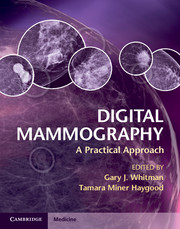Book contents
- Frontmatter
- Contents
- List of contributors
- Preface
- Acknowledgments
- Chapter 1 Detectors for digital mammography
- Chapter 2 Image acquisition
- Chapter 3 Preparing digital mammography images for interpretation
- Chapter 4 Image display and visualization in digital mammography
- Chapter 5 PACS, storage, and archiving
- Chapter 6 Interpretation of digital screening mammography
- Chapter 7 Efficacy of digital screening mammography
- Chapter 8 Artifacts in digital mammography
- Chapter 9 Mobile digital mammography
- Chapter 10 Procedures with digital mammography
- Chapter 11 Digital breast tomosynthesis
- Chapter 12 Breast computed tomography
- Chapter 13 Cases
- Chapter 14 Comparison of commercially available systems
- Index
- References
Chapter 7 - Efficacy of digital screening mammography
Published online by Cambridge University Press: 05 December 2012
- Frontmatter
- Contents
- List of contributors
- Preface
- Acknowledgments
- Chapter 1 Detectors for digital mammography
- Chapter 2 Image acquisition
- Chapter 3 Preparing digital mammography images for interpretation
- Chapter 4 Image display and visualization in digital mammography
- Chapter 5 PACS, storage, and archiving
- Chapter 6 Interpretation of digital screening mammography
- Chapter 7 Efficacy of digital screening mammography
- Chapter 8 Artifacts in digital mammography
- Chapter 9 Mobile digital mammography
- Chapter 10 Procedures with digital mammography
- Chapter 11 Digital breast tomosynthesis
- Chapter 12 Breast computed tomography
- Chapter 13 Cases
- Chapter 14 Comparison of commercially available systems
- Index
- References
Summary
Introduction
Screening mammography, whether performed using digital or analog technique, is the best method available of finding breast cancer at an early, potentially curable, stage. This has been demonstrated in numerous articles. One study from 2009 combined information from several large databases to study Texas women. These authors compared women living in a county with a mammography facility to those living in counties adjacent to a county with a facility and to others living in counties with no mammography facility either in that county or in an adjacent county. They discovered that merely living in a county with a mammography facility made women significantly more likely than women living in counties without mammography facilities to undergo screening and, even more importantly, more likely to have a breast cancer diagnosed at an early stage rather than a more advanced stage [1]. Diagnosis of cancer at earlier stages does translate into prevention of death from breast cancer [2–4]. Berry et al. used seven different statistical models to investigate causes of a drop in the breast-cancer death rate from 49.7 per 100 000 women aged 30–79 in 1990 to 38.0 per 100 000 in 2000. Depending on the model employed, the estimated contribution of screening to this drop in the breast-cancer death rate ranged from 28% to 65%, with the remainder of the drop being attributed to improvements in treatment [5].
Most of the literature regarding the benefits of screening mammography utilizes data from film-screen technique. There is every reason, however, to suppose that these benefits would also apply to digital mammograms. Weigel et al. studied the epidemiology of breast cancer in the Műnster/Coesfeld/Warendorf area of Germany, comparing the years 2002–04, before screening mammography was routinely offered, and 2005–07, following the introduction of a digital screening program [6]. Before screening was implemented, the average breast-cancer detection rate was 297.9 cases per 100 000 women. After screening was implemented, the detection rate jumped to 532.9 cases per 100 000 women, presumably due to earlier discovery of cases that would otherwise have lain hidden until being found clinically at a later date. Without screening, 15% of breast cancers were ≤ 10 mm in diameter and 64% were node-negative. Of cancers detected through the screening program, 37% were ≤ 10 mm in diameter and 75% were node-negative [6].
- Type
- Chapter
- Information
- Digital MammographyA Practical Approach, pp. 62 - 70Publisher: Cambridge University PressPrint publication year: 2012



